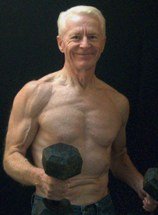Hi

April 1, 2018
In this newsletter . . .
Practical training
after age 50
I wrote much of the following about five years ago. It’s been updated where appropriate.
I like reading other newsletters about training and visiting other fitness websites. You learn a lot about what is smart training and what is not. Recently, I read a newsletter from Brooks Kubic. Mr. Kubic is a lawyer, author and a strongman, now in his 50s.
He wrote about being a high school wrestler and the long, grueling workouts he went through and how strong and fit he was for wrestling competition. Today, in his 50s, he still trains heavy but emphasizes short workouts consisting of basic lifts. He readily admits the kind of training he did as a young man
would wear him down today.
Yesterday I pulled into a parking space near a park and saw a woman stuffing medicine balls into the back of an SUV. I asked her what they were for and she said she runs an outdoor boot camp that meets in the park. We each had a dog and they got to know each other while we
talked for a few minutes.
She was a mature woman, I’d guess in her mid- to late-50s. We talked about fitness and she told me she preferred outdoor workouts to gyms. I told her I had led cardio-kickboxing classes into my late 60s. But at my age now I couldn’t possibly handle the intensity of those workouts [I was a mere age 76 when we had the conversation]. She agreed that we must adjust our training as we grow older. But having done that, the key then is to keep moving and never stop.
For years, I kept training logs. I can look back and see what I was doing five, 10, or 15 years ago. If I allowed it, dwelling on what I did back then could be pretty discouraging when compared to what I do today. So I try not to give it much thought. In those days, I would lead a kickboxing group one night, lift heavy weights the next night, and hike on the weekends. Today I follow the same formula
of resistance training and cardio. But weights I lift today are minuscule compared to 14 years ago, and any cardio work is a faint shadow of what it once was.
Of course I’d be lying if I said I don’t wish I could do all the things I did as a younger man. Who wouldn't? But that’s life. My point is this: (a) you must keep moving, but keep it age appropriate, and (b) don't concern yourself with what used to be.
What I think, specifically
As we get older, higher repetitions with moderate weights usually make more sense than lifting the heavy stuff. And, especially, all-out one rep maximum efforts that send your blood pressure through the roof are not the way to go. Also be sure to take a little more time warming-up, and always taper off to cool down. Practice some gentle stretching, too.
In the wise words of Satchel Paige: "Don't look back. Something might be gaining on you."
They're also known as "Roller Coasters.” But the Marines call them Dive Bombers, and I like that. Once you've mastered standard push-ups, you might want to try your hand at these. They're great all around upper-body strength and muscle builders. They're not for beginners though. If you're just starting out, build up to them gradually by first getting proficient with standard push-ups.
Your comments and questions are always appreciated. Simply click on the "Reply" bottom.
Sincerely,
Logan Franklin
The Gray Iron Fitness Newsletter
www.senior-exercise-central.com



